The hidden side of the mountains that cut through Australia’s heart
By Andrew Bain
At Heavitree Gap in Alice Springs, a mountain range effectively snaps in half. To the gap’s east stretch the East MacDonnell Ranges, while the more popular West MacDonnell Ranges unfurl to the west. They are mountains made familiar to many by their gorges – Ormiston Gorge, Standley Chasm, Simpsons Gap – and the presence of the Larapinta Trail, one of Australia’s headline multi-day hikes. But peer beyond the known and there are new and intriguing ways to see this spectacular line of mountains across Australia’s heart.
Rodna
Growing up around Hermannsburg, Benji Kenny knows the West MacDonnell Ranges’ gorges intimately, but there’s one gorge that’s closest to his heart.
“This is my favourite part of the world right here,” he says as we stand beside a waterhole in Rodna, its angular red cliffs rising overhead like the rusted hull of an enormous ocean liner. Though out of sight of all roads, Rodna is little more than two kilometres from one of the West MacDonnells’ best-known gorges, but few outsiders have ever seen it, or even know of its existence.
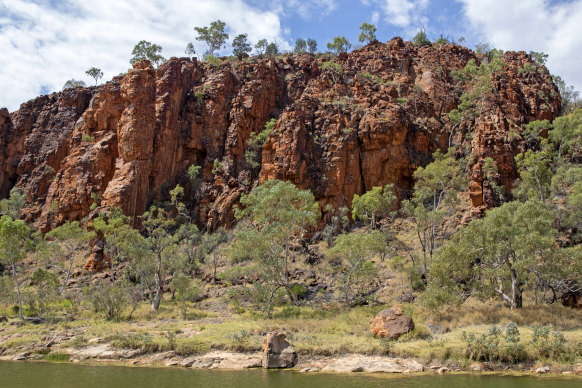
Secret spot – the Gorge at Rodna.Credit: Andrew Bain
Kenny, Rodna’s traditional owner, hopes to change that as he opens the area to visitors on tours with his 100% Finke River Culture and Adventures company or Alice Springs Expeditions.
To get here, we’ve bumped along rough bush tracks for an hour through desert coloured with the brief, rain-induced appearance of wildflowers. Our first stop is one of immense significance – a tin shed at Rodna Bore, the spot where, Kenny recently discovered, one of the earliest meetings in the movement towards the Aboriginal Land Rights Act was held in the late 1960s.
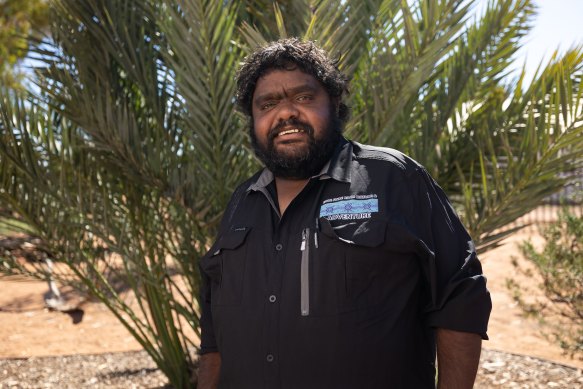
Benji Kenny of 100% Finke River Culture and Adventures.
The journey into Rodna’s gorge is along the banks of the Finke River, said to be the world’s oldest waterway, flowing 650 kilometres from its headwaters in the West MacDonnell Ranges before fading out ingloriously into the sands of the Simpson Desert.
Along the river’s largely dry course through Rodna, we pass waterholes that form part of a dog Dreaming story (“Rodna” translates as dog’s jawbone) with the souls of dogs from around the country said to come to this place.
Rodna’s immense beauty is truly revealed as the track heads down onto the Finke’s stony riverbed and the cliffs of the gorge close in. A deep, green waterhole stretches from cliff to cliff and, beyond it, I can see the back of the famous gorge that, even now as we stand in silence, will be crawling with visitors.
“Rodna is a very special place, not only for my family, but I think it’s really rich and it’s rare to see a gorge that’s so nice and quiet and peaceful,” Kenny says. “What me and my family want to do is put Rodna back on the map. It’s a really important place and we want more and more people to come and see it.”
Kenny’s vision for Rodna includes camps, walking tracks and mountain bike trails, but tourism is so new that no infrastructure yet exists – overnight tours lay out tents in the soft sand beside the waterhole. But to sit here at the waterhole’s edge, knowing that the hubbub of tourism is just two kilometres and yet world’s away, is the purest form of luxury and privilege.
Yeperenye Trail
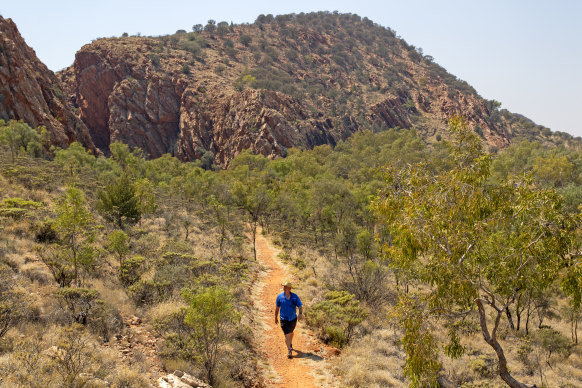
Hiking out from Jessie Gap on the Yeperenye Trail.
At the mouth of Jessie Gap, the wild figs are close to fruiting, and flocks of zebra finches swoop past like tiny Roulettes. The dry creek bed through the gorge is as wide as a dual-lane highway but, unlike most visitors here, I’m not heading into the gorge. Instead, I’m walking away from it, on a trail across the arid slopes of the East MacDonnell Ranges.
The largest-ever investment in infrastructure by an Aboriginal group in Central Australia, the 8.2-kilometre Yeperenye Trail was constructed by the Eastern Arrernte traditional owners in 2021, connecting Jessie Gap to Emily Gap, the closest gorge to Alice Springs.
They are gorges that carry a degree of anonymity, overshadowed by the more popular chasms in the West MacDonnells, guaranteeing that I’m almost alone on the well-designed trail. As it rises up the slopes, I’m quickly peering down onto lands coloured like an ochre mural and so neatly vegetated with saltbush that they resemble a cultivated garden. Ahead, the tails of planes at Alice Springs Airport’s storage facility rise above the mulga scrub like shark fins.
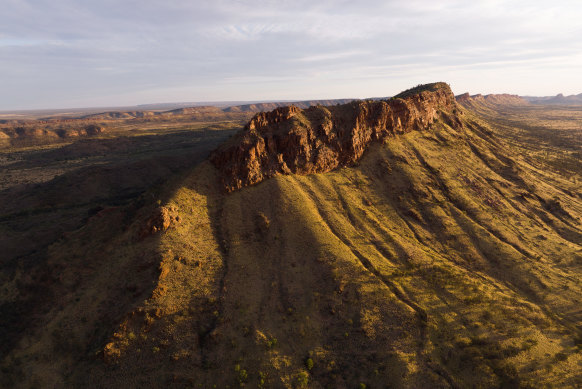
Tjoritja / West MacDonnell Ranges – just west of Alice Springs.
At first, birds sing me along the trail, which is also open to mountain bikers, but by its midpoint, far from the life-sustaining waterholes at each end of the trail, there’s silence. Cliffs rise overhead and colourful jump-ups break the uniformity of the valley below.
After about six kilometres, as the trail briefly steps away from the range, rising over a low knoll to provide a wider perspective on the mountains, Emily Gap first appears, seemingly chiselled into the mountains ahead.
It’s at about this point, as I approach the gap, that signs of desert life return: a sand goanna scuttling through the bush, dingo scat beside the trail, bloodwood trees weighed down with bush coconuts like Christmas baubles, and the return of finches, which interpretive signs along the trail have told me used to be eaten by the Arrernte people and, yes, tasted like chicken.
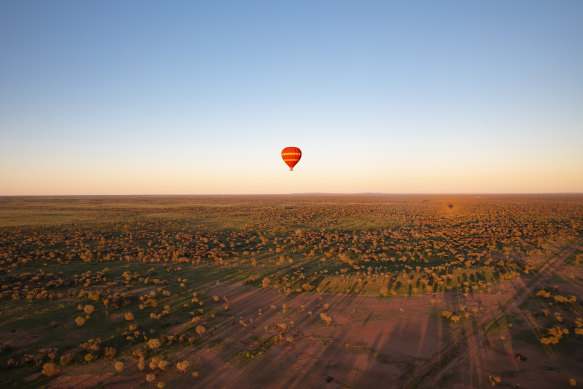
The view from above – hot-air ballooning and the spectacular dawn colours of the MacDonnell Ranges.
Hot-air ballooning
In the near darkness of the pre-dawn, there’s barely a bump as a 12-storey-high balloon lifts lightly off the desert sand in a clearing south of Alice Springs and the MacDonnell Ranges.
Snatched by the prevailing winds, the balloon drifts west, passing over the Finke Desert Race track, the Ghan railway and the Stuart Highway, though it’s the long line of the ranges that forms the biggest part of the view.
It’s usually hard work to gain elevated views in the MacDonnells, but sunrise ballooning brings them easily. From the basket of the balloon, I look out onto the mountains, so neatly partitioned by gorges and gaps, with Alice Springs visible through Heavitree Gap only as streetlights at this early hour.
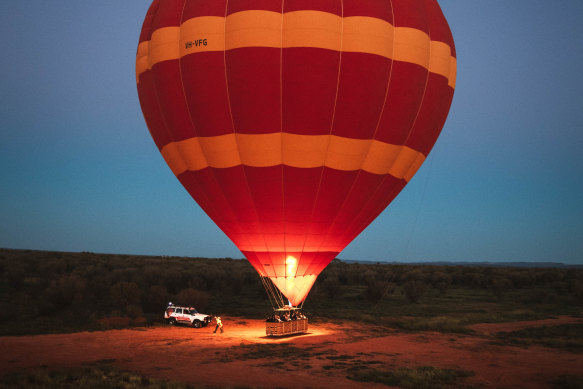
The flight is almost silent, broken only by the intermittent blast of the balloon’s burner.
With the winds blowing at around 30 kilometres per hour, pilot Duncan holds the balloon low, beneath the strongest gusts, prolonging our flight as the mountains draw ever nearer. Below us, the vast stretch of land we can see south of the ranges constitutes just two massive outback cattle stations, while ahead, limiting the range of our flight, is the Pine Gap defence facility.
The flight is almost silent, broken only by the intermittent blast of the balloon’s burner. After about 20 minutes the sun emerges, as red as a stoplight, over the eastern horizon, which is topped by the Opera House-like figure of Mount Undoolya in the East MacDonnells.
Too quickly, we’re skimming low over the sparse treetops as the balloon comes into land in a paddock. As we brace our backs against the basket’s edge, the balloon skids briefly across the sand and gently tips over.
Even here, lying sideways in a toppled basket, the rocky slopes of the MacDonnell Ranges demand our attention, glowing brightly with the first red rays of the morning. Another fine day in the MacDonnell Ranges has begun.
THE DETAILS
Visit
Rodna can only be visited on tours with 100% Finke River Culture and Adventures and Alice Springs Expeditions. See 100adventure.com.au; alicespringsexpeditions.com.au
Balloon flights are operated by Outback Ballooning. See outbackballooning.com.au
Stay
Thirty minutes’ drive outside of Alice Springs, Ooraminna Station Homestead provides a classic outback stay in remote cabins, with restaurant, bar and pool among spectacular rock formations. See ooraminna.com.au
The writer travelled courtesy of Tourism NT. See northernterritory.com
Sign up for the Traveller Deals newsletter
Get exclusive travel deals delivered straight to your inbox. Sign up now.